Pharm Exec's 11th Annual Press Audit
The results of this year’s survey indicate that the media’s scrutiny of pharma increased in 2014,with drug safety again again sitting atop of the list of hot button issues.
The Annual Press Audit of issues in the pharmaceutical industry audit, sponsored by the Arrupe Center for Business Ethics at Saint Joseph’s University, tracks and analyzes the industry issues covered by the media. The results of this year’s survey indicate that the media’s scrutiny of pharma increased in 2014, continuing a three-year trend and establishing a five-year high. Drug safety again sits atop of the list of hot button issues, with R&D and healthcare reform next on the list.
Some of the top findings for 2014 include:
- Coverage of the industry has been trending up and was up again this year, increasing by 44% over last year to 196 articles.
- Drug safety dominated the news again, retaining its top position among hot button issues. R&D for new drugs, healthcare reform, high drug prices and the industry’s interaction with the FDA also received heavy coverage in 2014.
- The focus on healthcare reform was largely around the implementation of Obamacare with the same number of articles as last year – 60, with the New York Times accounting for half of the articles. There was a slight shift in the coverage from negative to neutral.
- Media coverage of the industry continues to be more critical than positive or neutral. In 2014, 47% of articles were negative toward the industry, which is the same figure as last year by well above the five-year average of 37%.
- Newly emerging issues in 2014, appearing on the hot button list for the first time, were tax inversion, ebola, and drug abuse.
Processing the news
To be included in the study and in our EthicsTrak database[1], an article had to be published between October 1, 2013 and September 30, 2014 in one of the top five US newspapers (as measured by circulation) - USA Today, Wall Street Journal, New York Times, Los Angeles Times, and the Washington Post. It also had to (a) focus on an ethical or legal issue facing the pharma industry and (b) appear either as a front-page story or on the editorial page - an indication of major news and public sentiment.
The purpose of the audit was to shed light on the following questions:
- What ethical and legal controversies face the pharma industry-and what kinds of coverage do they attract?
- Do the articles and headlines support or oppose the positions taken by the industry, as defined by the Pharmaceutical Research & Manufacturers’ Association (PhRMA)?
- How often do reporters include the industry’s perspective in the stories that cover the issues of the day?
- What pharmaceutical companies and brand names are identified and discussed in the articles?
- What are the implications of these findings for the industry?
For each article, we examined four elements: issues, headlines, tone, and balance.
Figure 1 shows the number of articles for 2014 compared to previous years. Results indicate that the amount of coverage the industry received is up 44% year over year and well above the five-year average of 136 articles.
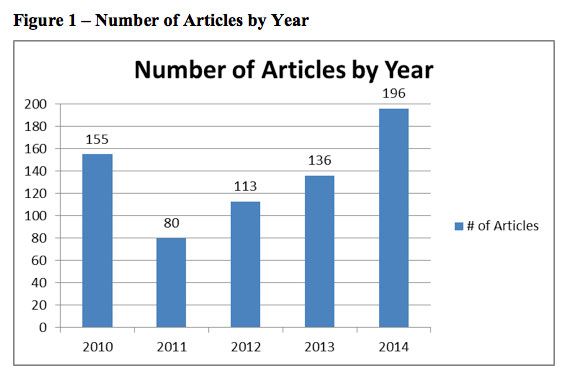
Table 1 below shows the breakdown of coverage by newspaper. The 44% increase in coverage of the industry for the year reflects increased coverage across all of the newspapers, including a four-fold increase in the Wall Street Journal.

What are the “hot button” issues?
Table 2 identifies the issues covered in the articles, the frequency of their coverage, and how the results compare to previous years. Retaining its top spot on the list of topics attracting media attention is drug safety, an issue that typically signals bad news for the industry. Drug safety has held the number 1 or 2 spot on the list in six of the last seven years. This year we identified and tracked 61 articles on drug safety, the same number as last year. Almost one of three articles on the industry (31%) in 2014 included a focus on drug safety. For example, “Spike in Harm to Liver Is Tied to Dietary Aids” (New York Times, December 23, 2013) focused on dietary supplements linked to increasing rates of liver disease. The interaction of prescription drugs and dietary supplements may have adverse effects. The article explains that supplements are much less regulated than are prescription drugs. Likewise, “Medicines Made in India Set Off Safety Worries” (New York Times, February 15, 2014) focused on counterfeit medicines produced in India and consumed in the U.S.

Second on the list this year was research & development of new drugs, which is typically good news for the industry. Coverage of the R&D issue more than tripled this year, moving up from fifth place to second place and from 14 to 48 articles. The New York Times, in “In Single Gene, a Path to Fight Heart Attacks” (June 19, 2014), reported on efforts to find a drug to combat heart disease by discovering a mutation in a gene that protects against heart attacks by keeping triglyceride levels low. Some reports on the R&D issue, however, pointed toward the challenges of sustaining R&D in the industry. The Wall Street Journal, for example, reported “Merck to Cut Staff by 20% As Big Pharma Trims R&D” (October 2, 2014).
Healthcare reform, discussed below, placed third on the list this year followed by high drug prices and interaction with the FDA. Articles on drug pricing articles are predominantly negative for the industry. Examples include “Refusals to Pay High Drug Prices” (New York Times, June 25, 2014) and “Prices of new drugs tough to take; Promising therapies for hepatitis C cost up to $1,000 a pill, and insurers and taxpayers may bear the burden” (Los Angeles Times, March 10, 2014).
Moving on to the list this year after minimal to no coverage in previous years were the issues of tax inversion with ten articles and Ebola with nine. Examples of the focus on tax inversion include a New York Times article (May 3, 2014) noting that pharma and technology are frequent users of the tax dodging strategy and a Wall Street Journal article defending Pfizer for its tax inversion strategy with an AstraZeneca merger (May 14, 2014).
The Ebola virus and the World Health Organization’s formal declaration of an international public health emergency in response to the virus was a major news story. The Director General of the WHO, Dr. Margaret Chan, called it ''the largest, most severe, most complex outbreak'' of the deadly Ebola virus ''in the nearly four-decade history of the disease'' (“Controlling the Ebola Epidemic,” New York Times, August 11, 2014). The L.A. Times reported on the challenges pharma companies face as they rush to respond to the Ebola crisis (“Use of Ebola drug raises red flags; Medical experts say skipping clinical trials has downsides,” August 6, 2014).
Marketing and sales incentives, which has always attracted at least some coverage and was near the top of the list just a few years ago, fell off the list entirely this year. This lack of coverage is a positive outcome for the industry, and may reflect new policies and procedures in place to regulate incentives to physicians.
Identification of pharma companies
For the third year in a row, there were specific mentions about pharma companies and/or their products. This year there were 455 mentions about 24 companies and/or 61 of their products, which were dramatically more than the 26 mentions identified last year. Pharma companies that were most mentioned include GlaxoSmithKline with 15, AstraZeneca with 12, Johnson & Johnson with 10 and Bristol-Myers Squibb with seven (7). Most often, this coverage was negative, as was the case with the Wall Street Journal article about ATRIPLA, the HIV-1 infection drug from B-Ms/Gilead Sciences (“Drug-Cost Surprises Lurk inside New Health Plans
Wall Street Journal, December 3, 2013). As the financial implications of healthcare reform begin to emerge, pharma companies, as one of the key stakeholders in healthcare delivery, are readily identifiable as a cost component of healthcare delivery.
Coverage
Our eleven-year analysis has found that the tone of headlines and articles tends to be more negative than positive for the industry. This year headlines were slightly more negative than last year but the articles themselves were slightly more positive. Table 3 shows these results. The modest decrease in negative articles is good news for the industry but the four-year trend is not good, moving from 21.2% in 2011 to 46.9% in 2014. On the other hand, there has been an uptick in positive articles as well, from 23.9% in 2012 to 29.1% this year, with a corresponding drop in articles that were neutral to the industry. As shown in Table 3, headlines remain more than twice as likely to be negative (37.7%) than positive (16.3%) toward the industry.
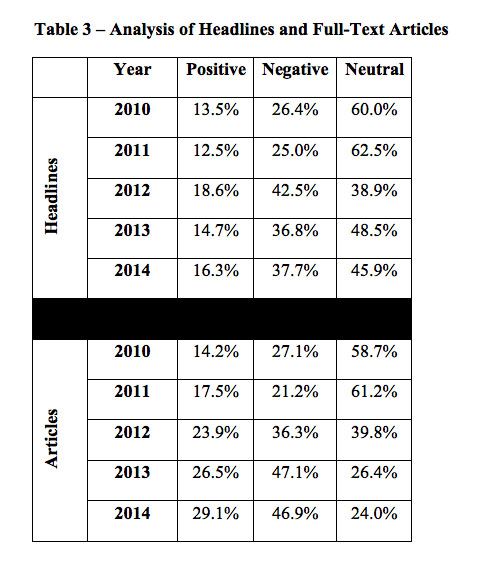
Regardless of whether the article takes a primarily positive or negative tone toward the positions of the industry, our audit analyzes whether both sides of the disputed issue are at least acknowledged. This year 49.0% (96 of 196) of articles mentioned both sides, a drop from last year’s mark of 58.4%.
Healthcare reform
The coverage this year was exactly what it was last year, 60 articles, as depicted in Figure 2. This level of coverage is not surprising because attention to healthcare is linked to the implementation and challenges with the implementation of the Patient Protection and Affordable Care Act (PPACA or Obamacare). While the number of articles was the same, the papers contributing to the total changed. Three papers, the USA Today, the Wall Street Journal and the New York Times increased. Based on the number of articles, the New York Times’ increase was most prominent, going from 21 to 30 articles. Two papers, the Los Angeles Times and the Washington Post, had decreased coverage. The Los Angeles Times decreased from 20 to 11 articles (45%) and the Washington Post decreased from 15 to nine (9) articles (40%). Comparing the editorials and front-page articles, all papers had more editorials than front-page articles, except the Wall Street Journal, which had the same number. See details in Table 4 further below.

Analyzing the coverage of healthcare reform
As in previous years, we analyzed the top five U.S. newspapers to address the following questions:
- Do the healthcare articles and headlines support or oppose the positions taken by the pharmaceutical industry?
- What ethical issues face the pharma industry in these articles on reform?
- How often are the industry’s perspectives included in the articles?
- What pharmaceutical companies and/or brand names are identified in the articles?
- What are the implications of these findings for the industry?
The headlines as well as the articles were analyzed as positive, negative, or neutral toward the pharmaceutical industry. There was definitely a centrist tone to this year’s articles with about twice as many neutral articles as positive and negative articles combined. When positive and negative articles were compared, there were more negative headlines (28.3% vs. 15%) and full-text articles (28.3% vs. 20%). These results are consistent with results we have seen for the past five years. Note the summary in Table 5 below.
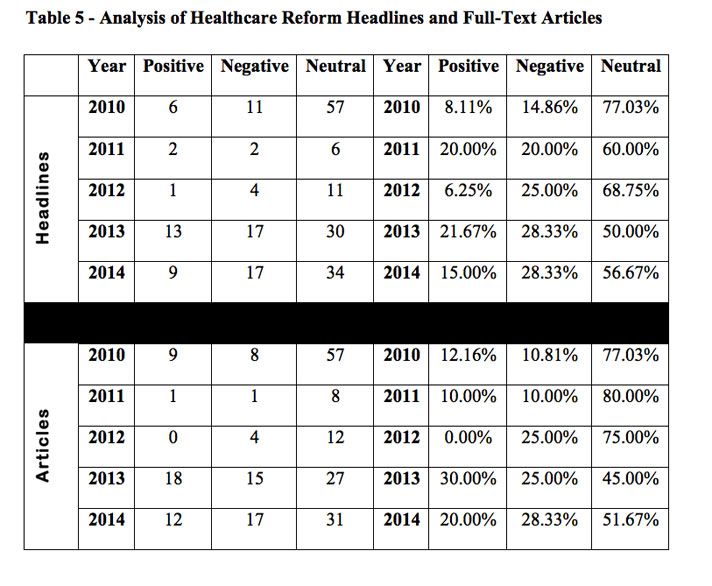
When coverage by individual newspaper was assessed, all papers except the Wall Street Journal had more neutral articles than either positive or negative articles. Interestingly, the Wall Street Journal had the highest percentage of negative articles (50%) than neutral or positive articles. For the other four newspapers, two papers, the USA Today and the Los Angeles Times had more positive than negative articles with 33.3% vs. 16.7% and 27.3% vs. 9.1% respectively. The Washington Post was evenly split between positive and negative articles with 22.2% each. Over the last five years, all papers were more neutral (60.6%) and slightly more negative than positive (20.7% vs. 18.8%). A summary of this coverage is depicted in Table 6 below.
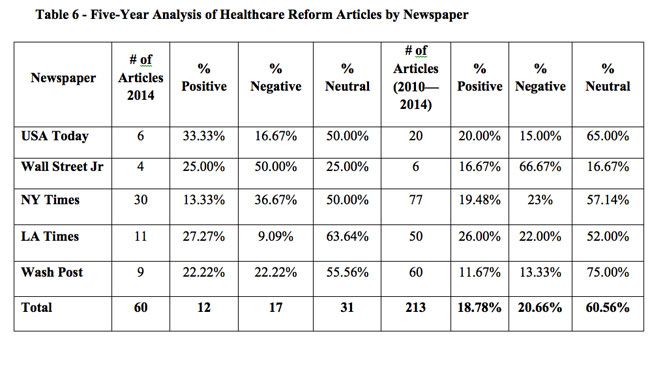
Healthcare reform key issues
This year articles that were specifically about Obamacare were the most dominant topic among healthcare reform articles, covered 40 times in the 60 articles. By comparison, the other 14 hot button issues were mentioned a combined total of 53 times in the articles as depicted in Table 7 on the next page. The focus on Obamacare is not surprising given the rollout of the PPACA. The most prominent of the other issues in healthcare reform was contraception, which replaced high drugs prices as the second most reported issue last year and is linked to providing contraceptive coverage as part of Obamacare.
Contraception was most reported by the New York Times with eight (8) followed by the Los Angeles Times with four (4). The controversial nature of this subject inspired coverage, such as that in the New York Times about the Supreme Court ruling requiring the Little Sisters of the Poor, who operate nursing homes, to file written notice of its religious objection to cover birth control (New York Times, January 28, 2014, p. 20) and the fierce dissent from the female members of the Supreme Court about a decision exempting a Christian college from providing contraception coverage under the Afford Care Act (New York Times, July 4, 2014, p. 1)
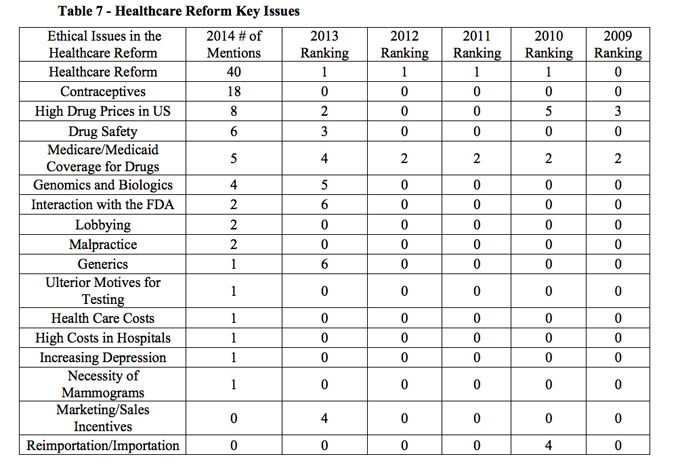
Implications for pharma?
This year’s newspaper coverage of issues that affect pharma companies and issues related to healthcare reform has several implications for the pharmaceutical industry. First, pharma remains a focal point of attention by the media as evidenced by the three-year trend of increasing coverage resulting in the highest coverage in five years. An issue that has been the most reported or second-most reported issue in six of the last seven years, drug safety, is being fueled by problems that are indirectly linked to pharma companies. Examples are the pharmacokinetic interaction between dietary supplements and prescription medicines and concerns about drugs manufactured in India. Research & Development, which usually generates positive coverage, has been tarnished by pharma companies’ decrease in R&D spending and staffs.
Issues related to challenges with Obamacare are significant because they directly impact pharma’s customers, patients and their ability to pay for healthcare and prescribed medicines. These issues range from the fact that people are not enrolling, which leaves the number of uninsured at about 41 million with another 29 million underinsured, many without a prescription drug benefit (http://www.marketwatch.com/story/6-major-hurdles-to-implementing-obamacare-2014-01-16?page=2 , 2015). Other factors that are ripe for media coverage and the potential to erode pharma’s market opportunities are the legalization of medical marijuana in the U.S. and its impact on cannabinoid-based drugs. It offers too many ways to skirt access by physician prescription (http://www.unitedpatientsgroup.com/ resources/ beginners-guide, 2015). Another is restriction and/or curtailment of the use of antibiotics in meat products the way they are currently banned in the EU, Australia, New Zealand and Japan (http://www.examiner.com/article /europe-is-rejecting-the-food-we-eat-the-us, 2015) Depending on the fair balance of media coverage, coverage about mandatory vaccinations for children can help the industry if a Reuters-Ipsos poll showing that a majority of Americans favor mandatory vaccinations but can hinder pharma if a link between vaccinations and autism is emphasized (http://bangordailynews.com/ 2015/02/26/news/nation/poll-most-americans-favors-mandatory-vaccinations/, 2015).
References
Europe Is Rejecting the Food We Eat in the US (2015). Accessed 23 Feb 2015.
http://www.examiner.com/article/europe-is-rejecting-the-food-we-eat-the-us
Poll: Most Americans Favor Mandatory Vaccinations (2015). Accessed 28 Feb 2015.
Why Big Pharma May Not Be Cashing in on Medical Marijuana (2015). Accessed 22 Feb 2015.
http://wallstcheatsheet.com/business/why-big-pharma-may-not-be-cashing-in-on-medical-marijuana.html/
About the Authors
George P. Sillup, Ph.D., M.S., is Arrupe Fellow & Associate Professor and Stephen J. Porth, Ph.D., is Associate Dean and Arrupe Fellow & Professor, both at Saint Joseph's University (SJU), Philadelphia, PA. Cynthia Slater, SJU’s Business Reference Librarian and SJU students, Dante Gleason, Caitlin Smith and Lauren Lang also contributed to this research.
[1] The EthicsTrak database contains assessments of 1,519 newspaper articles evaluated over a ten-year period.